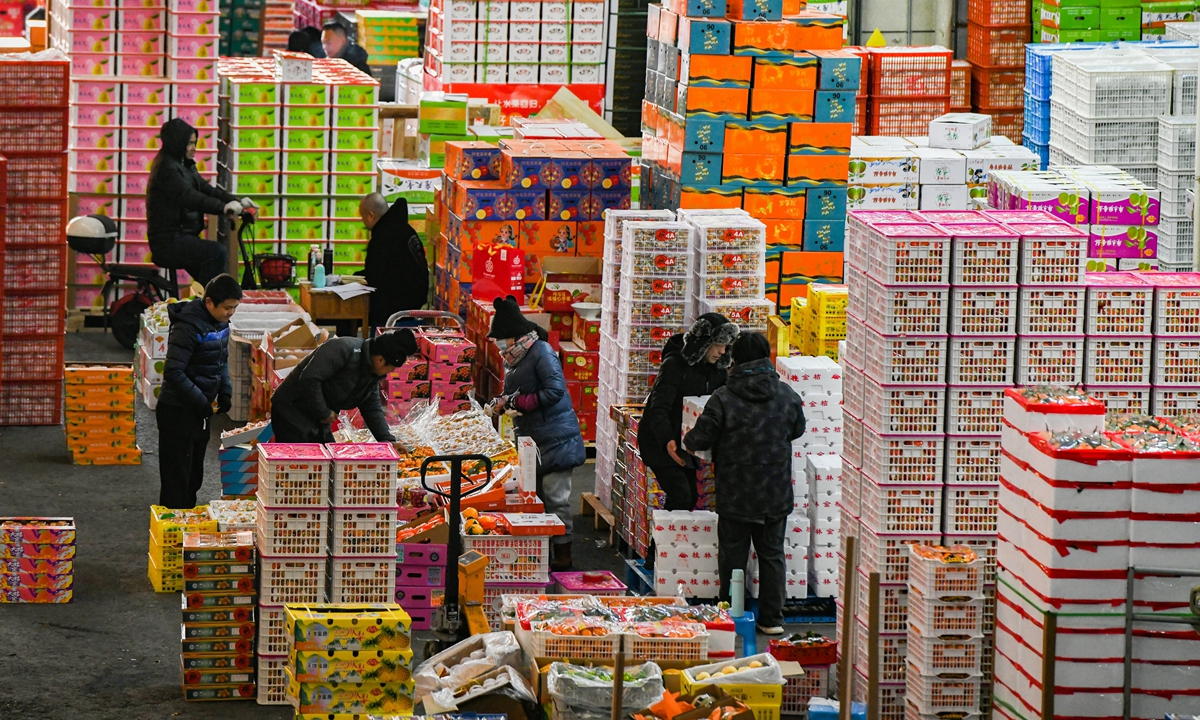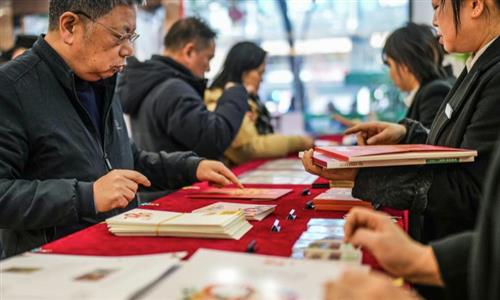
Vendors are busy stocking up on fruits at a wholesale market in Jinhua, East China's Zhejiang Province on December 22, 2024. With the New Year's Day and the Spring Festival holidays approaching, fruit sales have entered the pre-holiday peak season and fruit vendors are making preparations to meet holiday consumption demands. Photo: VCG
The China General Chamber of Commerce reported on Monday that the retail prosperity index rose to 51.1 points in January, up 0.7 points from the previous month and 0.2 points higher year-on-year. The data indicate increased confidence among retail enterprises in the consumer market.
The sub-index for merchandise businesses hit 51.8, up 1.8 points from December. The profitability sub-index climbed by 4.9 points, while the average transaction value index increased by 2.0 points, both marking their highest levels in a year, indicating a recovery in business performance.
Analysts noted that the uptick was largely attributed to the Chinese Lunar New Year shopping spree and recently launched trade-in programs by the government.
Several factors have contributed to the surge in consumer spending, with the upcoming Spring Festival holidays expected to boost spending on dining, tourism and shopping. Additionally, consumption vouchers issued by local governments have further unlocked consumption potential, said Zhou Rong, a senior researcher at the Chongyang Institute for Financial Studies at Renmin University of China, in an interview with the Global Times on Monday.
On Monday, Central China's Henan Province announced the issuance of Spring Festival consumption vouchers. The provincial government plans to distribute 200 million yuan ($27.3 million) in vouchers targeting the retail, dining, cultural tourism and accommodation sectors, and it has encouraged local governments to adopt similar measures.
Other regions, including East China's Shandong Province, Southwest China's Sichuan Province, North China's Hebei Province and North China's Shanxi Province, have introduced new policies for large-scale equipment renewals and consumer goods trade-ins, offering subsidies for the trade-in of automobiles, home appliances and other equipment.
The Central Economic Work Conference held at the end of 2024 outlined clear policy directions, putting the consumption boost at the top of the agenda in 2025. The Spring Festival holidays are projected to drive significant demand in lower-tier city markets, driven by festive shopping and a surge in homebound travel, according to the China General Chamber of Commerce.
Both consumption vouchers and consumer goods trade-in policies benefit consumers by offering quality products at competitive prices. They also help merchants promote new products, encouraging consumers to adopt new purchasing habits and buy high-quality, affordable goods, Zhou said.
At its core, China's products still stand out for their novelty, quality and convenience, and the new policies have helped stimulate purchasing enthusiasm, Zhou added.
Last year, the supportive measures delivered notable results. The Ministry of Commerce said that the trade-in program for consumer goods had driven more than 1 trillion yuan in sales as of December 13, 2024.
In 2025, the Chinese government plans to expand the issuance of ultra-long special treasury bonds to support the implementation of large-scale equipment upgrades and consumer goods trade-in programs, Yuan Da, a deputy secretary-general of the National Development and Reform Commission, told a press conference on Friday.
The government will broaden the range of areas eligible for funding, and consumers will receive subsidies to purchase three categories of digital products: mobile phones, tablets and smart watches or wristbands, said Yuan.



